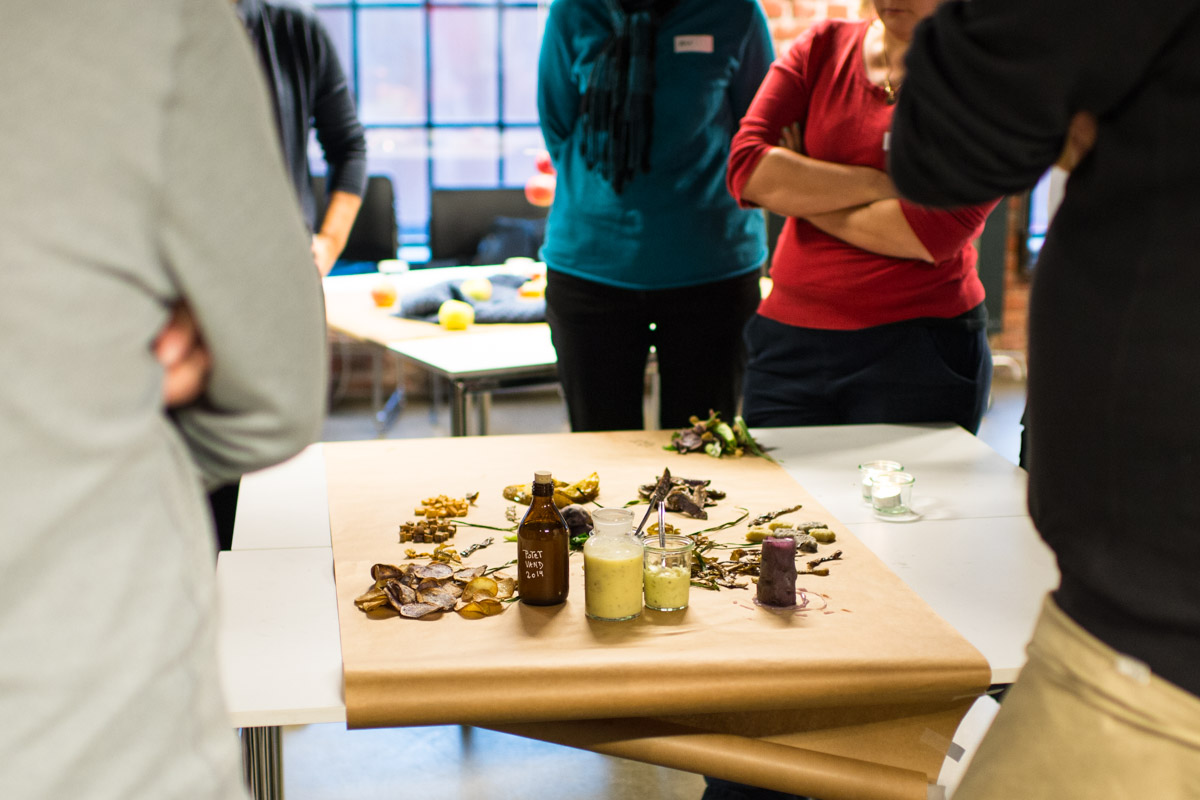Column
Food Tales
— Visuelt 2014
Let the Food Tell your Tale: A Foodlab at Visuelt
Each year Grafill hosts the largest gathering of creatives in the field of visual communications through Visuelt, a two-day conference and awards ceremony. The aim is to inspire and function as a meeting point. This year Grafill launched a new approach to the conference hosting it as a festival with Mathallen, Oslo’s largest food market, as the main location.
On the Friday, a one of a kind workshop, addressing the topic Food Design, gathered 20 creative food-lovers exploring how the story of sustainability and food can be communicated through food design. The participants were challenged to prepare their own course, which were to tell its own unique story. But first, to get the participants going, we explained all about food design, and the work that Food Studio carries out. With this knowledge our participants were challenged to explore new ways of storytelling through edible experiences and work towards creative and innovative small courses.
– Food design is not just about the looks of the plate or the product, but also the creating of tastes, texture, sounds, consistency, smell and so on. Sometimes food and table-settings are ceremonial and formal, but sometimes a meal is merely a bare necessity, says designer and responsible for the workshop, Runa Klock.
Klock explains that the way a meal is created and put together, communicates values, meanings and feelings.
– In this way cooking and preparing food is similar to that of designing. Color, more than anything, makes us expect certain tastes, the play with colors can certainly create unexpected and exiting experiences, says Klock.
In the end, inspired by the graphic profile and colors of Visuelt 2014, the participants were challenged to create a meal that communicates a story.
In addition to hosting the workshop, Food Studio were also making sure over 400 conference goers were provided with healthy, natural food the first day of the seminar. For this event Food Studio was delighted work alongside Oslo’s “King of Coffee,” Tim Wendelboe, as well as the team behind the remarkable Food Evolution. This year’s concept was to highlight the possibilities of a meal based on the recourses of one single farm, Fokhol in Stange, where the meat, the dairy, the vegetables and the grain were harvested altogether. (bio-dynamic approach).
As part of the experience, the team went preparing the food at the farm, harvesting it from the field, preparing it in the local kitchen that normally is used to feed the workers at the farm, and at the same time enjoying a week in the beautiful surroundings of Stange. Fokhol farm is run as an ideological foundation which aim is to produce ecologic food and spread the happy concept of biodynamic agriculture. This way of harvesting the country builds on the idea of the farm as an individual organism which functions without interference from the outside.
The result of the menu was a breakfast which consisted of toasted oat and quark, while the lunch was either a salad with seasonal vegetables, spelt, apple and pickled onion, with a mustard vinaigrette, or a tartine of ancient grain with boiled pork and the ecological cheese Nyr with fresh herbs. The fluid to go with was raspberry lemonade, and later in the afternoon energy bars were served as a snack.
Any conference with self-respect ads coffee as a vital component, and for this event Food Studio decided to continue the fruitful cooperation with former world barista champion, Tim Wendelboe, to serve something beyond the usual cup of hot black liquids. For the conference Tim had selected a special coffee for us to serve from the small coffee plantation Finca Tamana in Pital, Colombia some 400km south of the capital Bogotá. Tim has been working with the farmer Elias Roa for just over a year to improve quality, and already these efforts have started to yield results
We drip brewed the coffee freshly for each break and served it black with no cream or sugar on offer to let its true underlying flavors shine through.
It was packed with aromas and flavors of citrus, brown sugar and berries with a slight citric acidity. This was a clean, smooth brew with a juicy mouthfeel and lingering sweet finish. Hopefully, we managed to show people that coffee doesn’t have to be the acrid burnt stuff that is so often served at these sorts of events, and that a good coffee, prepared in the right way, can be as nuanced as the finest of wines.
Words by Gina Aakre
Photographs by Svein G. Kjøde








